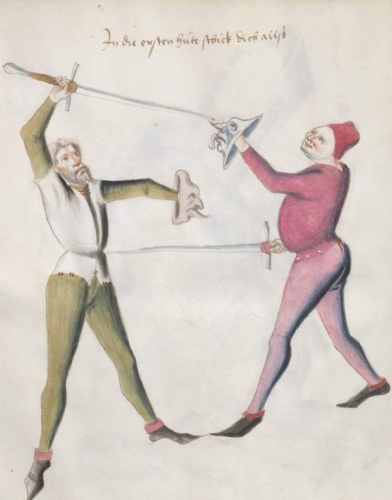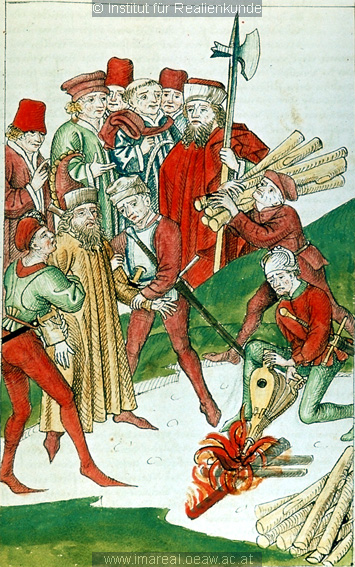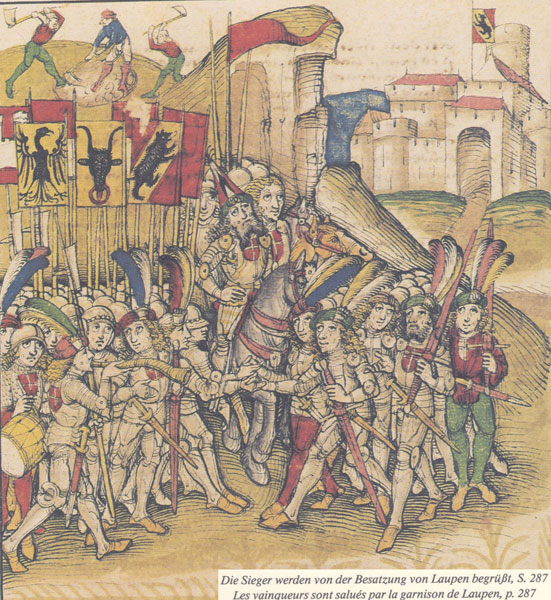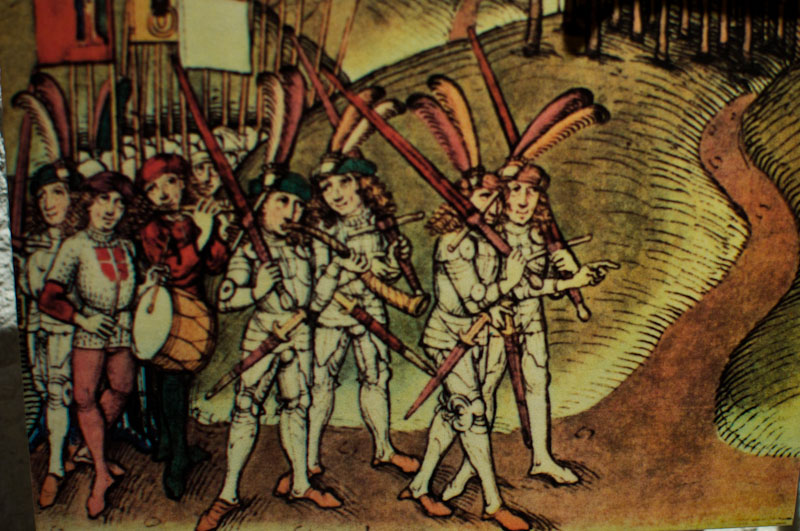| Author |
Message |
|
Levente M.
Location: Hungary Joined: 19 Aug 2009
Posts: 35
|
 Posted: Mon 11 Jun, 2012 4:52 am Post subject: 15th century "two-handed swords" Posted: Mon 11 Jun, 2012 4:52 am Post subject: 15th century "two-handed swords" |
 |
|
Hello!
In the Castillon find there were - if I remember correctly - 3 bigger swords. One of them weighs more than 2 kg and has quite a large blade and a long grip. I attached a photo of it. I also attached the description of the sword which names it "two-handed sword".
There's also the sword Arms and Armor based their english two-handed sword on. It weighs almost 3 kg and is quite large as well. Very similar to the sword mentioned above.
The terminology of swords has never been clear to me, what do you call a longsword, a bastard sword or a two handed sword etc.
However this sword looks to me just like some swords in Talhoffer's fencing book, which makes it a longsword in my mind. It definitely doesn't look like the montantes and doppelhanders of the 16th century.
So basically my question is, what was the function of these swords? What are they?
Now I have two theories, but i'm quite new to the world of swords so I could be very wrong.
1. They were longswords used by large men. For example, I'm quite tall, 195 cm and have big hands. Albion's Talhoffer feels small to me, there's almost no space between my hands when I hold the grip. I also feel i could handle more weight and I'd be more effective with a longer blade.
2. It was used similarly to a zweihander, pollaxe or halberd, and a secondary, smaller sword was carried on the belt.
So can someone clear up my confusion please? 
Thanks!
 Attachment: 5.81 KB Attachment: 5.81 KB

 Attachment: 214.25 KB Attachment: 214.25 KB

 Attachment: 212.1 KB Attachment: 212.1 KB
[ Download ]
|
|
  |
 |
Scott Hanson

|
 Posted: Mon 11 Jun, 2012 6:54 am Post subject: Posted: Mon 11 Jun, 2012 6:54 am Post subject: |
 |
|
I don't have any data to back you up, but my opinion is the same as yours: these were for use by larger men. I'm only 188 cm tall, but I still feel like the Albion Talhoffer is a bit short and light for me, and I would prefer something larger.
Proverbs 27:17 "As iron sharpens iron, so one man sharpens another"
Wisconsin Historical Fencing Association (WHFA)
A HEMA Alliance Affiliate
|
|
  |
 |
|
Scott Woodruff
|
 Posted: Mon 11 Jun, 2012 6:56 am Post subject: Posted: Mon 11 Jun, 2012 6:56 am Post subject: |
 |
|
Cool, I did not realize that that sword was so large. It is indeed like a larger version of the Talhoffer. I have had a similar experience to yours, most longswords seem a bit too small for me. I recently read an article whose author offered the opinion that WMA practitioners should use longer longswords because that makes the techniques "clearer". With the smaller swords (90cm blade) larger people can more easily disengage from the bind and are less likely to work from the bind as the manuscripts show. He offered a lot of evidence from period longsword manuscripts that longswords would be quite large in proportion to their users. I will try to remember where I saw that article and post a link if I find it. I would definitely call the sword you showed a longsword rather than a two-handed sword, but that is really just an opinion. There is evidence that swords even this large were worn on the belt, so the original user of this sword would not necessarily wear a smaller sword on his belt, but no doubt this sword could have been a saddle sword.
Edit: tis isn't the one I was thinking of, but heres a few bits of info: http://willscommonplacebook.blogspot.com/2007...sword.html And:
http://historical-academy.co.uk/blog/2011/07/...longsword/
Last edited by Scott Woodruff on Mon 11 Jun, 2012 7:44 pm; edited 1 time in total
|
|
  |
 |
|
Craig Shackleton
|
 Posted: Mon 11 Jun, 2012 7:39 am Post subject: Posted: Mon 11 Jun, 2012 7:39 am Post subject: |
 |
|
I have a general hypothesis that longswords in general moved towards having longer grips over time to make them easier to control. With a longer grip, the balance also changes and makes it easier to manage a longer, heavier blade.
In the Dobringer Hausbuch, at one point the author says that you should hold your hands close together at the middle of the grip as a pivot point. Later, in Ringeck and von Danzig, there are techniques that require thrusting the pommel under your right arm with your left hand. These techniques work better with your hands further apart on the grip, and in the later manuals with illustrations we often see the hands far part with the left hand on the pommel.
I work primarily with von Danzig, and a significant part of my interpretation of the blossfechten section is that the right hand drives the sword forward, and then the left hand redirects the sword using leverage. This lets you redirect the sword in mid-motion without stopping your momentum.
Similarly having your hands far apart gives you a better structure in guard positions, especially ochs. If your hands are close, it easier to displace the point as the sword pivots at your hands.
The more longsword I do, the more I like longer, heavier swords with long grips. I don't really like using a longsword that doesn't have room for at least another hand between my hands. My first longsword seemed oversized and awkward when I got it. I am now considering getting a bigger, heavier one for training.
Ottawa Swordplay
|
|
   |
 |
|
Ryan S.
|
 Posted: Mon 11 Jun, 2012 8:12 am Post subject: Posted: Mon 11 Jun, 2012 8:12 am Post subject: |
 |
|
the terminology can be confusing, part of it is because the same terms could apply to different weapons, and historical terms are not clear. The modern jargon is much more specific, but I am still not sure on the exact difference between a arming sword and a longsword. A hand and a half sword has room for two hands, but it is not required. A true two hander requires two hands to control it. Neil Melville, estimates at least 100 cm for the blade and 140cm overall. That is a little more than 4 ft 7 in. Melville also gives the weight of two handers as over 2 kg, which is almost 5 1/2 pounds. Some twohanders have extra features that only two handers have, such as parrying hooks, but not all two handers have them.
Here is the article: http://www.ejmas.com/jwma/articles/2000/jwmaart_melville_0100.htm
|
|
  |
 |
|
Craig Shackleton
|
 Posted: Mon 11 Jun, 2012 8:30 am Post subject: Posted: Mon 11 Jun, 2012 8:30 am Post subject: |
 |
|
Historically, a longsword is a sword intended to be used in two hands, with a grip long enough for both hands comfortably. Occasionally they could be used one-handed, especially while mounted.
The term longsword applied to swords intended to be used one-handed is a modern error (as far as I know), my guess being that it can be attributed to Dungeons and Dragons.
I do not know, and frequently wonder, how long the term "arming sword" has been around, my guess being that it is a modern reclassification/clarification of what was once just called a "sword."
Ottawa Swordplay
|
|
   |
 |
|
Aleksei Sosnovski
|
 Posted: Tue 12 Jun, 2012 2:20 am Post subject: Posted: Tue 12 Jun, 2012 2:20 am Post subject: |
 |
|
To throw in some more confusion, here are some images from Kal's manual.
First, a longsword in one hand, unarmored and on foot:

Second, a longsword in one hand, armored and on horse:
http://wiktenauer.com/images/d/d8/CGM_1507_12v.jpg
Third, a longsword in two hands, armored and on foot:
http://wiktenauer.com/images/f/f0/CGM_1507_25v.jpg
Fourth, a longsword in two hands, unarmored and on foot:
http://wiktenauer.com/images/4/49/CGM_1507_59r.jpg
Swords on the first 2 pictures look very similar, but swords on the other 2 are distinctly different. On the 3rd picture pommels have spikes and on the fourth there are schilts. Note that these are not federschwerts since their points are acute. One can't make any conclusions regarding size or proportions of these swords because Kal shows very different sizes and proportions on different plates, I suspect he simply didn't care about them, but the general types seem to stay constant. I think that there were "longswords" designed for both 1 and 2-handed use as well as "longswords" designed mostly for 2-handed use, sometimes to the point where using such sword 1-handed is impossible except for some occasional strikes and deflections when the other hand is busy for example holding opponent's arms. And for unarmored training and duels mostly the latter ones were used. A mounted man at arms would expect to use his sword mainly one-handed while on horse so he would choose a sword more suitable for 1-handed handling.
One funny thing that I just noticed when previewing this post is that "rainguards" are different on plates showing armored and unarmored combat. On "armored" plates these are tubular, while on "unarmored" plates rainguards are simple semicircles on both sides of the blade. These seems to be so for all other plates as well, at least for the ones I checked.
|
|
   |
 |
Matt Easton

Location: Surrey, UK. Joined: 30 Jun 2004
Posts: 241
|
|
    |
 |
|
Ryan S.
|
 Posted: Tue 12 Jun, 2012 5:14 am Post subject: Posted: Tue 12 Jun, 2012 5:14 am Post subject: |
 |
|
| Craig Shackleton wrote: | Historically, a longsword is a sword intended to be used in two hands, with a grip long enough for both hands comfortably. Occasionally they could be used one-handed, especially while mounted.
The term longsword applied to swords intended to be used one-handed is a modern error (as far as I know), my guess being that it can be attributed to Dungeons and Dragons.
I do not know, and frequently wonder, how long the term "arming sword" has been around, my guess being that it is a modern reclassification/clarification of what was once just called a "sword." |
Melville differentiates between swords that can be used with two hands, and those that need two hands. One could use two hands one on top of the other on a small sword to add more force, but only really big swords allow one to use certain two handed techniques. Those require a certain amount of distance between then hands, similar to a pole arm.
|
|
  |
 |
|
Craig Shackleton
|
 Posted: Tue 12 Jun, 2012 6:16 am Post subject: Posted: Tue 12 Jun, 2012 6:16 am Post subject: |
 |
|
@ Ryan: Right, but I was specifically speaking of the historical distinction, mainly the term "langenschwert" from the various German sources, and of course "longsword" vs. "short sword" as distinguished by George Silver. Melville is a modern source (unless I am grossly mistaken) making a modern distinction. I also think that (at least from a HEMA perspective) the distinction between can be used/must be used two handed is not as useful as the distinction between is intended to be used one handed or two handed, or even the distinction between can be used one-handed, cannot be used one-handed and cannot put two hands on the grip at all.
@Matt: Cool. I feel a lot better about using that term now.
@Aleksei: I forgot about Kal using longswords for sword and buckler. It's an interesting outlier. The spiky longswords are pretty common, usually in armoured combat depictions, especially judicial foot combat. I am now curious as to why Kal had different swords depicted in each of those scenarios. I had previously assumed the longsword with buckler was just because that's what he had on hand, but then why that particular longsword instead of the same ones in the blossfechten section? I can guess, but at this point it would be just guessing.
Ottawa Swordplay
|
|
   |
 |
|
Aleksei Sosnovski
|
 Posted: Tue 12 Jun, 2012 6:59 am Post subject: Posted: Tue 12 Jun, 2012 6:59 am Post subject: |
 |
|
|
Well, my experience tells me that when both hands are available for handling a sword a longer (and thus heavier) weapon has an advantage over a shorter one. But such weapon would not be very usable in one hand. So when one knows that he will be fighting with a sword in two hands (such as unarmored judical combat) he would probably choose a weapon specifically optimized for such purpose and that weapon would be pretty long and heavy. But when one expects to be using his weapon in one hand but still wants a two-handed grip he will choose a shorter and lighter weapon. I think that Kal simply depicts these two general types of swords. So swords depicted on the first two plates are "universal" weapons that can be used effectively enough in both one and two hands, swords on the third plate are optimized for armored combat on foot and swords on the last plate are optimized for two-handed use without armor on foot. It is just my theory though.
|
|
   |
 |
Matt Easton

Location: Surrey, UK. Joined: 30 Jun 2004
Posts: 241
|
 Posted: Tue 12 Jun, 2012 7:52 am Post subject: Posted: Tue 12 Jun, 2012 7:52 am Post subject: |
 |
|
It’s entirely possible that Kal’s plates of sword and buckler are supposed to represent a civilian street fight and people did not generally walk around wearing huge great two-handers, because they are a pain in the butt to wear. Most ‘longswords’ in museums from the 14th-15thC are not very long, either in blade or hilt. Swords are sidearms, until they become too long to conveniently wear at the side. Remember that most swords spent most of their lives being worn, not fought with.
Matt
Schola Gladiatoria - www.swordfightinglondon.com
YouTube: www.youtube.com/user/scholagladiatoria
Antique Swords: www.antique-swords.co.uk/
|
|
    |
 |
|
Levente M.
Location: Hungary Joined: 19 Aug 2009
Posts: 35
|
 Posted: Tue 12 Jun, 2012 8:31 am Post subject: Posted: Tue 12 Jun, 2012 8:31 am Post subject: |
 |
|
Thank you, very interesting theories!
So Matt, you say that a sword was mainly a sidearm in battle and has to be small enough to wear on a belt. This sword is definitely not comfortable to wear in a scabbard as a sidearm.
Others (including myself) said they prefer longer swords for duelling.
Following this logic I got to the conclusion: This sword is made for fencing and dueling, not for battle.
Why was it found with other, clearly "battle swords" then? Is it possible, that this weapon isn't a sidearm? That leads back to my original post, point 2., that the sword was used as zweihanders or pollaxes. Maybe in some rare cases people preferred swords to pole weapons, maces etc.? That's why there aren't that many big swords like this?
|
|
  |
 |
|
Aleksei Sosnovski
|
 Posted: Tue 12 Jun, 2012 8:38 am Post subject: Posted: Tue 12 Jun, 2012 8:38 am Post subject: |
 |
|
There are many possibilities. This sword might have been intended for a very large person. It could have been intended to be used as a primary weapon. I could have been intended for duelling but somehow ended up with "clearly battle" swords. They all are more or less equally realistic so choose which version you like the most 
|
|
   |
 |
|
Scott Woodruff
|
 Posted: Tue 12 Jun, 2012 8:42 am Post subject: Posted: Tue 12 Jun, 2012 8:42 am Post subject: |
 |
|
|
How long is the sword in question? Swords well in excess of 50" were routinely worn on the belt as sidearms during the 15th century. However, Matt is correct that most swords of the longsword/bastard sword persuasion are fairly compact. Here is one example of a long longsword on the belt. http://www.albion-swords.com/swords/johnsson/altdorfer.htm
|
|
  |
 |
|
Nicholas A. Gaese
Location: Montreal, Quebec, Canada Joined: 06 Aug 2007
Posts: 100
|
 Posted: Tue 12 Jun, 2012 10:32 am Post subject: Posted: Tue 12 Jun, 2012 10:32 am Post subject: |
 |
|
It seems to me that people then had worn even very large swords at the waist, it needn't be small and compact if you know how to work around it. Likewise there are various depictions of such large twohanded swords kept in it's scabbard and carried over the shoulder. So If you ask me, the sword in question could be a battle sword, likewise it could also be a dueling weapon, perhaps it was both at some point in time.
regards.
 Attachment: 200.09 KB Attachment: 200.09 KB

Swabian German, circa 1465. Men with large swords at the waist.
 Attachment: 139.83 KB Attachment: 139.83 KB

Swiss artwork, circa approx.1470-1500. Large swords held freely in scabbards, and used as primary weapons.
 Attachment: 189.16 KB Attachment: 189.16 KB

Swiss artwork, circa approx.1470-1500. Large swords held freely in scabbards, and used as primary weapons.
|
|
  |
 |
Luka Borscak

|
 Posted: Tue 12 Jun, 2012 12:12 pm Post subject: Posted: Tue 12 Jun, 2012 12:12 pm Post subject: |
 |
|
|
I highly doubt such two handed swords were ever made primarily as dueling weapons. They may have been popular for dueling but I think they were primarily swords for battle, like big XIIa and XIIIa swords of 13th and 14th century. They were usable from horse, either two handed in a melee against other horsemen or maybe by big strong individual for one handed passing blows from a moving horse and probably most practical as two handed weapons for dismounted use in a line of men at arms with short polearms like poleaxes...
|
|
  |
 |
Matt Easton

Location: Surrey, UK. Joined: 30 Jun 2004
Posts: 241
|
 Posted: Wed 13 Jun, 2012 2:13 am Post subject: Posted: Wed 13 Jun, 2012 2:13 am Post subject: |
 |
|
The images posted above are nice examples, because they show the people with big swords seem to mostly have them as a primary weapon, whereas the men carrying other primary weapons, such as halberds, have either shorter swords or baselards as sidearms. I think in general it is not right to directly compare a bastard sword with a true two-handed sword, as the former is usually a sidearm whilst the latter is usually a primary arm.
Matt
Schola Gladiatoria - www.swordfightinglondon.com
YouTube: www.youtube.com/user/scholagladiatoria
Antique Swords: www.antique-swords.co.uk/
|
|
    |
 |
|
Ryan S.
|
 Posted: Wed 13 Jun, 2012 6:40 am Post subject: Posted: Wed 13 Jun, 2012 6:40 am Post subject: |
 |
|
|
when are the earliest estimates for when civilians started carrying swords? or at least become required part of a gentleman's wardrobe? What was the use of the sword (and other weapons) outside of battle or tournament?
|
|
  |
 |
Luka Borscak

|
 Posted: Wed 13 Jun, 2012 7:04 am Post subject: Posted: Wed 13 Jun, 2012 7:04 am Post subject: |
 |
|
Edit: False information given...
Last edited by Luka Borscak on Wed 13 Jun, 2012 3:03 pm; edited 1 time in total
|
|
  |
 |
|
|
You cannot post new topics in this forum
You cannot reply to topics in this forum
You cannot edit your posts in this forum
You cannot delete your posts in this forum
You cannot vote in polls in this forum
You cannot attach files in this forum
You can download files in this forum
|
All contents © Copyright 2003-2025 myArmoury.com — All rights reserved
Discussion forums powered by phpBB © The phpBB Group
Switch to the Basic Low-bandwidth Version of the forum
|

